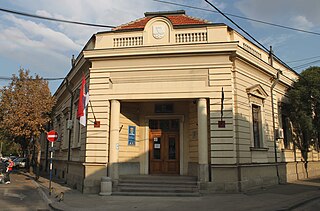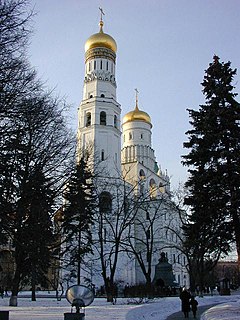
The Hilandar Monastery is one of the twenty Eastern Orthodox monasteries in Mount Athos in Greece. It was founded in 1198 by Stefan Nemanja, former Grand Prince of Serbia (1166-1196), who upon relinquishing his throne took monastic vows to become the ordinary monk Symeon, soon joining in Mount Athos his son Saint Sava, who later became Archbishop of Serbia. Upon foundation, monastery became a focal point of Serbian religious and cultural life, as well as "the first Serbian university". It is ranked fourth in the Athonite hierarchy of 20 sovereign monasteries. The Mother of God through her Icon of the Three Hands (Trojeručica), is considered the monastery's abbess.

The Studenica Monastery is a 12th-century Serbian Orthodox monastery situated 39 kilometres (24 mi) southwest of Kraljevo and 40.9 kilometres (25.4 mi) east of Ivanjica, in central Serbia. It is one of the largest and richest Serb Orthodox monasteries.

The Jablanica District is one of nine administrative districts of Southern and Eastern Serbia. It expands in the south-eastern parts of Serbia. According to the 2011 census results, it has a population of 215,463 inhabitants. The administrative center of the district is the city of Leskovac.

The Trinity Lavra of St. Sergius is the most important Russian monastery and the spiritual centre of the Russian Orthodox Church. The monastery is situated in the town of Sergiyev Posad, about 70 km to the north-east from Moscow by the road leading to Yaroslavl, and currently is home to over 300 monks.

Žiča is an early 13th-century Serbian Orthodox monastery near Kraljevo, Serbia. The monastery, together with the Church of the Holy Dormition, was built by the first King of Serbia, Stefan the First-Crowned and the first Head of the Serbian Church, Saint Sava.

Mileševa is a Serbian Orthodox monastery located near Prijepolje, in southwest Serbia. It was founded by King Stefan Vladislav I, in the years between 1234 and 1236. The church has frescoes by the most skillful artists of that time, including one of the most famous in Serbian culture, the "White Angel", which depicts an angel on Christ's grave.

The Kovilj Monastery is a 13th-century Serb Orthodox monastery in the Bačka region, in the northern Serbian province of Vojvodina. According to the legend, the monastery was founded by the first Serb archbishop, Saint Sava in the 13th century. The monastery, often cited as one of the most beautiful, has been nicknamed the "Jewel of Bačka". Considered "one of the most monumental cultural-historical objects in Bačka", it is protected by the state since 4 August 1949 as the cultural monument.
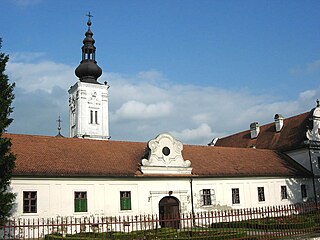
The Bođani Monastery is a Serbian Orthodox monastery in the Bačka region, in the northern Serbian province of Vojvodina. The monastery is near the village of Bođani, in the Bač municipality. Among the few Serbian Orthodox monasteries in the Bačka, Bođani is the oldest.

Monastery Dragović is a Serbian Orthodox monastery situated on a hill downstream the Cetina River not far from Vrlika in Croatia. When the artificial Peruća Lake was created, the original monastery sank due to land movement. The new monastery Dragović was built on a hill not far from the previous one.

Kosmaj is a mountain south of Belgrade, the capital of Serbia. With an elevation of 626 meters, it is the highest point of the entire Belgrade City area and is nicknamed one of two "Belgrade mountains".
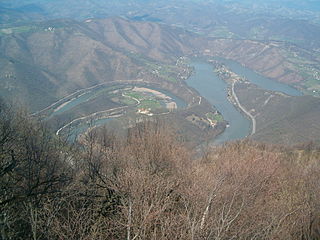
Ovčar-Kablar Gorge is a gorge in the western Serbia, part of the composite valley of the West Morava river. With over 30 monasteries built in the gorge since the 14th century, it is known as the "Serbian Mount Athos".
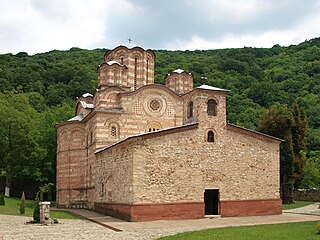
Ravanica is a Serbian Orthodox monastery on Kučaj mountains near Ćuprija in Central Serbia. It was built in 1375–1377 as an endowment of prince Lazar of Serbia, who is buried there. The Ravanica church is called the birthplace of the new artistic movement "Morava school" because of architectural and artistic features. It is original blend of the Mount Athos and the cross-in-square five-domed model that became standard in the time of King Milutin.

Krupa monastery is a Serbian Orthodox monastery on the Krupa River in Croatia. It is the oldest Orthodox monastery in Croatia.
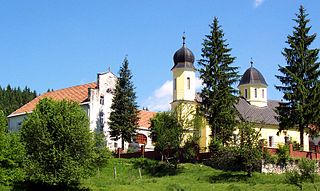
Gomirje is a Serbian Orthodox monastery in Croatia. It is the westernmost Serb Orthodox monastery, located in the western part of Croatia near the village of Gomirje, near the town of Ogulin. The monastery is thought to have been founded in 1600. The monastery includes the church of Roždenije saint John the Baptist, built in 1719.

The Church of St. Achillius, or the Arilje Monastery is a Serbian Orthodox church in Arilje, western Serbia. It is dedicated to Saint Achillius of Larissa, a fighter against Arianism and participant of the First Council of Nicaea in 325. The church was built in 1296 by Serbian King Stefan Dragutin of the Nemanjić dynasty and is located in the center of town, on the elevated plateau above the large river valley and the river Moravica and Big Rzav, and represents the most dominant object in the Arilje region.

The Monastery of St. Nicholas is a Serbian Orthodox monastery built by the Grand Prince Stefan Nemanja between 1159 and 1166. It is situated in the center of the historical region of Toplica, near the present day city of Kuršumlija (Serbia), in the upper valley of Toplica river.

The Duži Monastery is a Serbian Orthodox monastery dedicated to the Intercession of the Theotokos and located 10 kilometres west of the city of Trebinje in southern Republika Srpska, Bosnia and Herzegovina. It is situated in the Popovo Plain, not far from the coast of the Adriatic Sea. It was first mentioned in historical sources in 1694, when it served as a refuge for monks from the nearby Tvrdoš Monastery which was then destroyed by Venetians during the Morean War. That year the see of the Serbian Orthodox Eparchy of Zahumlje and Herzegovina was transferred from Tvrdoš to Duži, where it remained until 1777, when the see was relocated to Mostar.

The LomnicaMonastery is a Serbian Orthodox monastery dedicated to Saint George and located near Šekovići in the region of Donji Birač in the eastern Republika Srpska, Bosnia and Herzegovina. The monastery's church and dormitory are built on a narrow flat area on a hillside beside a stream called Lomnica, from which the monastery received its name. In the local accent, the consonant pair mn is often pronounced as vn, hence the form "Lovnica". As lov means "hunt" in Serbian, this gave rise to legendary accounts of the monastery's foundation that connect it in some way with hunting or hunters. According to one of the legends, the area of Lomnica was a hunting ground of the Serbian King Dragutin Nemanjić, and it was he who built this monastery. The region of Donji Birač contains many medieval necropoleis with the characteristic stećak tombstones and other archaeological artifacts.
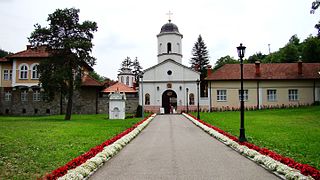
Rakovica Monastery is the monastery of the Serbian Orthodox Church, within the Archbishopric of Belgrade and Karlovci, located in the municipality of Rakovica in Belgrade, the capital of Serbia. It is dedicated to the archangels Michael and Gabriel.

The Tuman Monastery is a 14th-century Serbian Orthodox monastery in eastern Serbia, in the municipality of Golubac. It belongs to the Serbian Orthodox Eparchy of Braničevo. It is also referred to as the Tumane Monastery.


